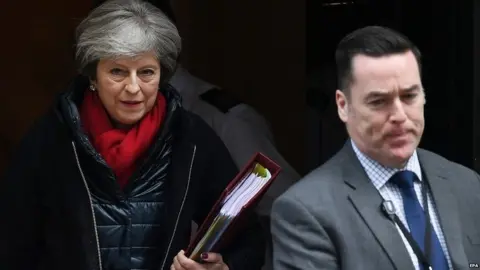Theresa May and ministers hammer out Brexit positions
 EPA
EPATheresa May has been chairing the first of two key Brexit meetings with senior ministers as the government faces more calls to clarify the UK's position.
The Brexit cabinet committee is to sketch out what the future relationship between the UK and EU might look like.
It was expected to focus on Northern Ireland and immigration.
It comes as a leaked document suggests the EU wants to be able to restrict UK access to the single market if there is a dispute after Brexit.
According to a draft section of the UK and EU's withdrawal agreement, which has yet to be finalised, the power to suspend "certain benefits" would apply during a transition phase after the UK leaves in March 2019.
The UK said the document simply reflected the EU's "stated directives".
It comes as further details emerged of the Treasury's estimates of the impact on the economy of Brexit.
According to the leaked estimates, the UK car industry's GDP would shrink by 1% if the UK remained in the EU single market but would lose 8% if there was a free trade agreement and 8.5% if the UK left without a deal and went to World Trade Organisation (WTO) rules.
Treasury estimates
MPs have also been allowed to see the impact assessments for their own regions. All regions will see their economies shrink, with the North East of England, the West Midlands, and Northern Ireland being the worst affected, according to the analysis.
The North-East would be hit hardest - with staying in the single market and customs union shaving 3% off GDP, an 11% reduction under a free trade deal and 16% under a no-deal WTO scenario,
London would fare the best, with reductions of 1%, 2% and 3.5% in each of the three scenarios.
Scotland's estimated hit would be 2.5%, 6% or 9%. Wales would see reductions of 1.5%, 5.5% or 9.5%.
Brexit-backing Conservative MP Jacob-Rees Mogg has accused Treasury officials of "fiddling the figures" to make all options but staying in the EU look bad, after the documents were first leaked to Buzzfeed last week.
The government said its preferred option - a bespoke deal covering trade and financial services - was not among those analysed in the leaked paper.
'Clean' separation
Speaking at Prime Minister's Questions, Mrs May restated the government's position that the UK would be leaving the single market and customs union and insisted she would be "robust" in getting the best deal.
"As I've said right from the very beginning, we will hear noises off, we will hear all sorts of things being said, of positions being taken," she said.
"What matters is the positions that we take in the negotiations, as we sit down and negotiate the best deal. We've shown we can do that, we did it in December and we're going to do it again."
The tensions within the Conservative Party were underlined on Monday when pro-EU former minister Anna Soubry told the BBC Mrs May should "sling out" arch Brexiteers, and threatened to quit the party.
Eurosceptics have been calling for a "clean" separation with the EU so the UK has the freedom to strike new trade deals, while pro-EU MPs say the UK should retain the closest possible access to the single market.
Former Chancellor Ken Clarke said Theresa May had to see "where the majority of opinion" was within the cabinet, offer some concessions and those who could not live with the agreed stance would have to resign.
He told BBC Radio 4's Today he wanted the UK to keep "most of the features of the customs union and the single market" after the transition period and suggested Parliament would back such a move.
But fellow Conservative MP Bernard Jenkin said Mrs May had "pushed back" against that position, which he said was at odds with the government's stated position of achieving "regulatory autonomy".
He told Today that "no-one" wanted a hard border on the island of Ireland or tariffs on trade between the UK and EU and it would be "perverse" if the EU ended up on insisting on them.
The 11-member European Union Exit and Trade (Strategy and Negotiations) sub-committee is a key part of the government's decision-making process.
Its members include Foreign Secretary Boris Johnson and Environment Secretary Michael Gove, who were at the forefront of the Leave campaign in the EU referendum, and Chancellor Philip Hammond and Home Secretary Amber Rudd, who campaigned for Remain.
They are expected to discuss trade at another meeting on Thursday.
'Wearing thin'
The EU's chief negotiator Michel Barnier said this week there is "not a moment to lose" in finding a deal before the end of the year.
Among those calling for more clarity on the UK's position is the British Chambers of Commerce, which has written to Mrs May asking for a "clear, unequivocal statement of intent".
"The perception amongst businesses on the ground, large and small alike, is one of continued division," it said.
"Even amongst the many optimistic, future-oriented firms - those who see opportunity in change - patience is wearing thin. Directly affected companies are poised to activate contingency plans. Many others, worryingly, have simply disengaged."
In response, Business Secretary Greg Clark said the UK's aims were very clear, namely tariff-free trade with the EU with a "minimum of frictions" in the years ahead.
Meanwhile, former transport minister Stephen Hammond has urged the UK to consider rejoining the European Free Trade Association, which it left in 1972 prior to joining the then European Economic Community.
Speaking in a debate in Parliament, he said membership of the free trade body - whose members are Iceland, Norway, Lichtenstein and Switzerland - was a "sensible option" which would give the UK the economic certainty and flexibility it wanted - although such an outcome has been rejected by ministers.
